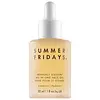What's inside
What's inside
 Key Ingredients
Key Ingredients

 Benefits
Benefits

 Ingredients Side-by-side
Ingredients Side-by-side

Citrullus Lanatus Seed Oil
EmollientNigella Sativa Seed Oil
EmollientPlukenetia Volubilis Seed Oil
EmollientPassiflora Edulis Seed Oil
EmollientCucumis Sativus Seed Oil
EmollientCitrullus Lanatus Seed Oil, Nigella Sativa Seed Oil, Plukenetia Volubilis Seed Oil, Passiflora Edulis Seed Oil, Cucumis Sativus Seed Oil, Cannabis Sativa Seed Oil, Rubus Idaeus Seed Oil, Cucurbita Pepo Seed Oil, Rosa Canina Fruit Oil, Opuntia Ficus-Indica Seed Oil, Helianthus Annuus Seed Oil, Tocopherol
Helianthus Annuus Seed Oil
EmollientVitis Vinifera Seed Oil
EmollientLimnanthes Alba Seed Oil
Skin ConditioningRosa Canina Seed Oil
EmollientHippophae Rhamnoides Fruit Oil
Skin ProtectingSqualane
EmollientOlea Europaea Fruit Oil
MaskingTocopherol
AntioxidantPlukenetia Volubilis Seed Oil
EmollientVaccinium Macrocarpon Seed Oil
Skin ConditioningPunica Granatum Seed Oil
EmollientRibes Nigrum Seed Oil
EmollientCamellia Japonica Seed Oil
EmollientBrassica Oleracea Italica Seed Oil
EmollientOpuntia Ficus-Indica Seed Oil
EmollientCucumis Sativus Seed Oil
EmollientCitrullus Lanatus Seed Oil
EmollientCannabis Sativa Seed Oil
EmollientAvena Sativa Kernel Extract
AbrasiveHelianthus Annuus Seed Oil, Vitis Vinifera Seed Oil, Limnanthes Alba Seed Oil, Rosa Canina Seed Oil, Hippophae Rhamnoides Fruit Oil, Squalane, Olea Europaea Fruit Oil, Tocopherol, Plukenetia Volubilis Seed Oil, Vaccinium Macrocarpon Seed Oil, Punica Granatum Seed Oil, Ribes Nigrum Seed Oil, Camellia Japonica Seed Oil, Brassica Oleracea Italica Seed Oil, Opuntia Ficus-Indica Seed Oil, Cucumis Sativus Seed Oil, Citrullus Lanatus Seed Oil, Cannabis Sativa Seed Oil, Avena Sativa Kernel Extract
 Reviews
Reviews

Ingredients Explained
These ingredients are found in both products.
Ingredients higher up in an ingredient list are typically present in a larger amount.
Cannabis Sativa Seed Oil is the fixed oil expressed from the seeds of the Cannabis sativa plant. This is also known as hemp oil.
Hemp oil is an emollient and nourishes the skin. It contains many fatty acids such as linoleic acid, amino acids, phospholipids, and vitamin E.
The difference between hemp and cannabis is their psychoactive component. Hemp has low amounts of THC.
Learn more about Cannabis Sativa Seed OilCitrullus Lanatus Seed Oil is made by expressing watermelon seeds. It is a non-fragrant oil with antioxidant and hydrating properties.
Watermelon seed oil contains a high percentage of linoleic acid and other fatty acids. These fatty acids make it a great skin hydrator. This ingredient may not be fungal-acne safe.
Cucumis Sativus Seed Oil is created from the seeds of the cucumber.
Cucumber seed oil is an emollient, meaning it helps hydrate the skin. Emollients create a barrier on the skin that prevents moisture from escaping.
Cucumber seed oil also contains Vitamin E, an antioxidant and soothing ingredient.
Learn more about Cucumis Sativus Seed OilHelianthus Annuus Seed Oil is the oil derived from the seeds of a Sunflower. Sunflower seed oil is non-fragrant. It is an emollient, meaning it helps to soften the skin.
Sunflower seed oil contains many fatty acids. The fatty acids found in sunflower seeds include (from highest amount to least): linoleic acid, myristic acid, palmitic acid, stearic acid, arachidic acid, oleic acid, and linolenic acid.
These fatty acids help the skin create ceramides. Ceramides play a role in repairing the skin barrier.
Helianthus Annuus Seed Oil helps moisturize the skin. This in turn helps the skin look more rejuvenated and smoother.
Sunflowers are rich in vitamin E.
Historians believe Indigenous cultures of North America domesticated sunflowers before corn. Thus they relied on sunflower oil for a variety of uses. One such use is moisturizing skin and hair.
Sunflower seed oil may not be fungal acne safe. We recommend speaking with a professional if you have any concerns.
Learn more about Helianthus Annuus Seed OilThis oil comes from the seed of the prickly pear cactus. Due to its ability to be easily absorbed, it does not leave a greasy feeling behind.
The main parts of this oil are fatty acids - linoleic, oleic, and palmitic. Other than that, the seeds also contains antioxidants such as vitamin E that help soothe the skin.
Due to its fatty acid content, this ingredient may not be fungal-acne safe.
Learn more about Opuntia Ficus-Indica Seed OilPlukenetia Volubilis Seed Oil is an oil and isn't fungal acne safe.
Tocopherol (also known as Vitamin E) is a common antioxidant used to help protect the skin from free-radicals and strengthen the skin barrier. It's also fat soluble - this means our skin is great at absorbing it.
Vitamin E also helps keep your natural skin lipids healthy. Your lipid skin barrier naturally consists of lipids, ceramides, and fatty acids. Vitamin E offers extra protection for your skin’s lipid barrier, keeping your skin healthy and nourished.
Another benefit is a bit of UV protection. Vitamin E helps reduce the damage caused by UVB rays. (It should not replace your sunscreen). Combining it with Vitamin C can decrease sunburned cells and hyperpigmentation after UV exposure.
You might have noticed Vitamin E + C often paired together. This is because it is great at stabilizing Vitamin C. Using the two together helps increase the effectiveness of both ingredients.
There are often claims that Vitamin E can reduce/prevent scarring, but these claims haven't been confirmed by scientific research.
Learn more about Tocopherol